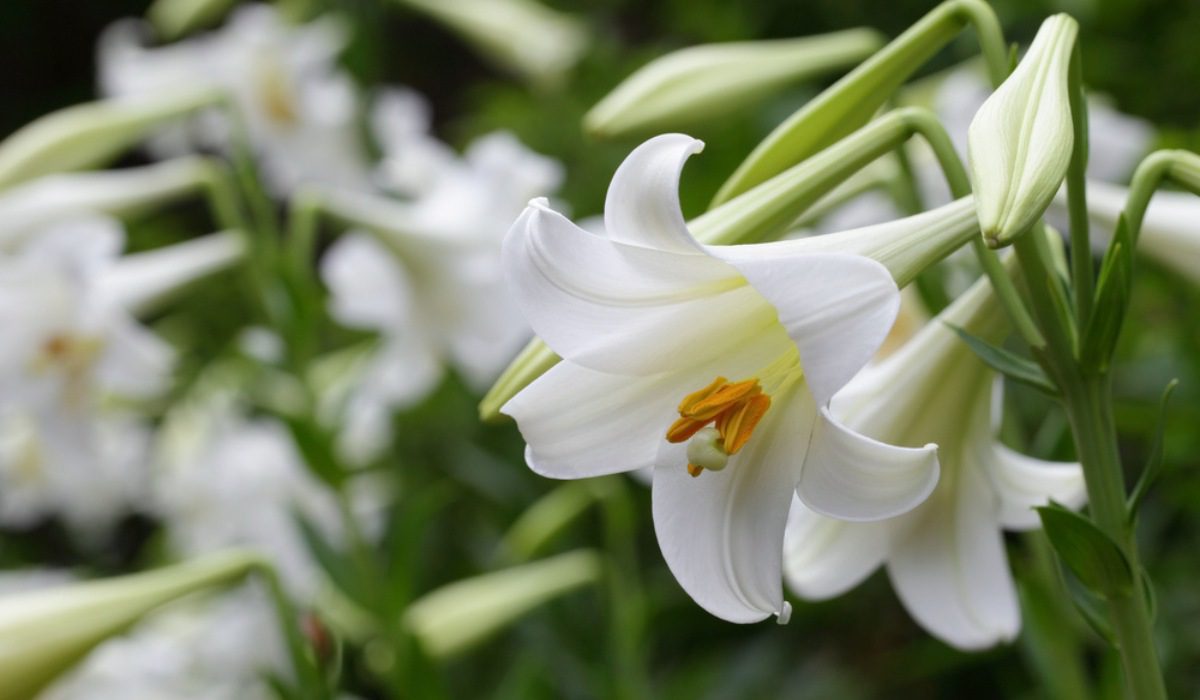The classic Easter lily, Lilium longiflorum ‘Nellie White,’ is a popular choice, forced to bloom during the holiday season. Also known as the trumpet lily or Bermuda lily, this perennial bulb has become a staple in Easter decorations. These trumpet-shaped blooms, symbolising the essence of spring, have become an integral part of Easter celebrations. This comprehensive guide delves into the key facts, varieties, propagation and care tips and even explores the potential toxicity of these enchanting flowers.
Easter Lily: Key Facts
| Common Name | Easter lily, trumpet lily, Bermuda lily |
| Botanical Name | Lilium longiflorum |
| Family | Liliaceae |
| Plant type | Perennial, bulb |
| Mature size | 2–3 ft tall, 1 ft wide |
| Sun exposure | Full, partial |
| Soil type | Loamy, well-drained |
| Soil pH | Acidic, neutral |
| Bloom time | Summer |
| Flower color | White, pink |
| Native area | Asia |
| Toxicity | Toxic to cats |
Easter Lily: Characteristics
The plants typically reach a height ranging from 50 cm (20 in) to 1 m (3 ft 3 in). They feature elongated oval leaves with veins running horizontally. During the flowering season from April to June, the plant produces pristine white flowers at the top of the stem. The stem is cylindrical, measuring approximately 5 cm (2.0 in) in diameter. These lilies boast tubular, 3- to 7-inch-long blooms, creating a visually stunning display in gardens. With origins in Asia, these perennials thrive in well-drained, loamy soil, showcasing their pristine white or pink flowers in the summer.
Easter Lily: Types
The world of Easter Lilies extends beyond the classic ‘Nellie White.’ Explore a bouquet of varieties, each with its unique size and colour:
- longiflorum ‘White Heaven’: Pure white blooms standing 2 to 3 foot high.
- longiflorum ‘Nellie White’: A popular cultivar forced to bloom during the holiday season.
- longiflorum ‘Deliana’: Yellow to creamy-yellow blooms on 3 to 4 foot tall stems.
- longiflorum ‘Elegant Lady’: A Dutch hybrid with fragrant pink flowers.
- longiflorum ‘Trimphator’: Eye-popping white blossoms with rosy pink centres.
Easter Lily: How to grow?
Growing these plants involve light, soil, water, temperature and fertilisation considerations. Here are some crucial steps to grow a healthy and alluring Easter Lily:
Where to plant Easter Lilies?
Easter lilies thrive in well-draining, rich soil with regular moisture. Due to their height, strategic placement providing support from other plants or using stakes is advisable.
How and when to plant Easter Lilies?
Plant bulbs in the fall, burying them twice their depth. Choose healthy potted lilies, ensuring deep green leaves and minimal signs of pests. Propagate them by division every two to three years.
Growing from seeds
While Easter lilies can be grown from seeds, it’s more common to use bulbs. Plant bulbs in fall or early spring, burying them about six inches deep.
Growing in pots
While possible, Easter lilies prefer gardens for insulation. In colder climates, move potted lilies indoors to prevent freezing.
Overwintering
In colder climates, move potted lilies indoors, adding insulation with straw or mulch to protect roots from freezing.
Easter Lily: Care tips
Easter Lillies: Light, soil and water requirements
Provide sunny to partially shady locations, avoiding full afternoon sun. Use well-draining soil, preferably sandy, and water regularly without letting the soil dry completely. Maintain soil moisture to prevent wilting.
Easter Lily: Temperature and humidity requirements
Adapted to zones 4–8, Easter lilies prefer temperatures around 21°C and humidity between 30–50%. Protect them from drafts and extremes in temperature.
Easter lily: Fertiliser and pruning requirements
Fertilise with a balanced mix during the growing season and high-phosphorus fertiliser when buds form. Minimal pruning is needed, mainly removing yellow leaves.
Easter Lily: Benefits and uses
- Ornamental Beauty: Adorn your garden or home with stunning trumpet-shaped blooms.
- Fragrance: Enjoy the sweet scent that fills the air during the blooming season.
- Perennial Charm: With proper care, Easter lilies can return each year, adding a perennial touch to your landscape.
Easter Lily: Common pests and diseases
Easter lilies are susceptible to scarlet lily beetles and aphids. Control aphids with water blasts or insecticidal soap. Diseases like Botrytis blight and stem rot can be prevented through daily care and immediate interventions.
Easter lily: Toxicity
A crucial aspect to note is the toxicity of Easter lilies, particularly to our feline friends. According to the FDA, all parts of an Easter lily are poisonous to cats, potentially leading to kidney failure. Caution is advised for pet owners, emphasising the need to keep these enchanting blooms out of reach of our furry companions.
FAQs
What are the different types of Easter lilies and their characteristics?
Several Easter lily varieties are present, such as 'White Heaven,' 'Deliana,' 'Elegant Lady' and 'Trimphator,' each offering unique colours, heights and fragrances.
Are Easter lilies pet-friendly?
These are toxic to cats, causing kidney damage. Keep them away from pets.
How do I care for an indoor Easter lily?
Place it in a sunny window, avoid over-watering, and water when the soil is dry.
How long do Easter lilies last?
With the right care, potted Easter lilies can survive for several weeks. Transplanting them outdoors extends their life.
When can I expect my transplanted Easter lily to rebloom outdoors?
They may take a year to bloom again, requiring patience for the next display.
What is the duration required for the blooming of an Easter lily bud?
It takes 30-40 days in gardens from bud to bloom, influenced by temperature.
Are Easter lilies suitable for growing in pots, and how can one overwinter them?
While Easter lilies can be grown in pots, they prefer gardens for insulation. In colder climates, it's recommended to move potted lilies indoors and provide insulation with straw or mulch to protect the roots from freezing.
| Got any questions or point of view on our article? We would love to hear from you. Write to our Editor-in-Chief Jhumur Ghosh at jhumur.ghosh1@housing.com |






